Translate this page into:
Assessment of practice of self-medication among the general public of Nagpur city – A cross-sectional survey

*Corresponding author: Fauzia Hasan, Third BDS, Ranjeet Deshmukh Dental College and Research Centre, (Formerly, VSPM Dental College and Research Centre), Nagpur, Maharashtra, India. fauzia2705@gmail.com
-
Received: ,
Accepted: ,
How to cite this article: Hasan F, Kahar AR, Joshi J. Assessment of practice of self-medication among the general public of Nagpur city – A cross-sectional survey. J Academy Dent Educ. 2024;10:55-63. doi: 10.25259/JADE_26_2024
Abstract
Objectives:
Self-medication is the use of medication to treat self-diagnosed disorders. These are commonly known as “non-prescription” or “over-the-counter” drugs. Since there is no prescription required, the drugs used to self-medicate can be obtained at pharmacies and supermarkets. People usually self-medicate when they have minor ailments such as cough, fever, and headache.The aim of this study was to evaluate the practice of self-medication among the general public of Nagpur city and correlate it with gender, age, and education.
Material and Methods:
A cross-sectional study was conducted among the general population of Nagpur by obtaining responses to a pre-validated questionnaire issued in interest. The study population included people of age group 18 years and above. The questionnaire was circulated among the general public of Nagpur city for a period of 1 month.
Results:
A total of 321 responses were collected. It was observed that 226 of the responders from both the genders self-medicated for a minor ailment and by repeated use of old prescription.
Conclusion:
Self-medication has become a norm among the general public of Nagpur city. Self-medication is influenced by prior experience with a medical condition and its management . It is vital to inform the public of the risk of antimicrobial resistance as well as the individual risk of harmful medication reactions.
Keywords
Self-medication
General public
Knowledge
Practices
INTRODUCTION
A drug is a chemical that affects the living processes and may be defined as any substance that brings about a change in biological function through its chemical actions.[1] Drugs have been used for centuries to treat, cure, prevent, and mitigate diseases and disorders of the human body; although drugs is a medicine, their dosage makes it poison.[2]
Self-medication refers to the practice of using over-the-counter medications or non-prescription remedies to treat minor ailments or manage symptoms without consulting a healthcare professional.[3] Careful self-medication has been suggested to be viewed as an educated, independent, and informed role in the management of diseases, with the potential to save treatment costs.[4-7] However, the practice of self-medication can be harmful due to a lack of medical knowledge, an increased risk of adverse drug reactions, delayed identification of underlying health issues, and the potential rise of antimicrobial resistance. The rapid emergence of antimicrobial resistance and the role of particulate matter 2.5 is among the factors of utmost concern, further stressing the importance of counseling and professional medical supervision in the consumption of medication.[8] Proper guidance is crucial to avoid these negative consequences and ensure accurate diagnosis and treatment. Self-medication can also lead to a delay in identifying underlying health issues, which can negatively impact individuals’ well-being[9-15] and a delay in achieving the United Nations Sustainable Development Goals (SDG), particularly SDG-3 (Good health and well-being), 4 (quality education), 11 (sustainable cities and communities), and 13 (climate action).[16]
It is not uncommon for people to prescribe medications to friends and family members without the necessary medical supervision. Since self-medication is so prevalent in our nation, it is nearly impossible for people to avoid doing so. The purpose of this study is to identify at a city level the frequency with which people indulge in the practice and the possible reason for the same. It is therefore imperative to determine the factors that lead to self-medication among people. It also focuses on several threatening consequences of improper use of medication.
MATERIAL AND METHODS
The aim of the study was to assess the practice of self-medication among the general public of Nagpur. The study also seeks to determine whether factors such as gender, age, and education are correlated with self-medication.
Study design was a cross-sectional survey, and the study tool was a pre-validated questionnaire with ten questions that were based on people’s knowledge and experiences with self-medication.[17,18] Given that the goal of the study was to determine whether age, gender, and education levels were associated with self-medication, the questionnaire also asked about demographics.
Ethical approval
The following study has been approved by the Institutional Ethical Committee of the affiliated institution (IEC/VSPMDCRC/03/2022) dated September 22, 2022.
Study population
Residents of the city of Nagpur, a cosmopolitan city of central India in the state of Maharashtra, the subjects chosen were of the age group 18 years and above and were included in the study with due consent.
Study procedure
A cross-sectional study was conducted among the general population of Nagpur through a validated questionnaire. The questionnaire consisted of sociodemographic factors such as age, sex, and education and ten questions pertaining to self-medication practice. The questionnaire was circulated among the general public of Nagpur city for a period of 1 month (October 13, 2022–November 15, 2022) through Google Forms through social media platforms.
For even sample distribution, the study participants were randomly selected from five zones of Nagpur, that is, east, west, north, south, and central, which represent Nagpur. The three investigators of the present study also visited public places in these five zones where different age group participants were available, and the data were collected for a period of 1 month.
The inclusion criterion for selection of the study participants was male and female participants of 18 years and older as participants above 18 years of age were deemed mature enough to fill out the questionnaire on their own.
The willing study participants were selected randomly and the questionnaire was filled by them by sharing an online Google form link. When a participant’s mobile device was unavailable, the investigators filled out some of the forms using their own phones. Unwilling participants and children (<18 years) were excluded from the study.
Statistical analysis
After the data had been acquired, it was entered into Microsoft Excel and subjected to percentage analysis. The comparison of the result according to age, gender, and literacy was also calculated by percentage analysis.
RESULTS
The public was asked to fill a questionnaire, and 321 respondents filled the questionnaire during the period of 1 month. Since the study was carried out with a focus on three distinct objectives, we categorized the data by gender, age, and education. Respondents ranged in age from 18 to 85 years, with a mean age of 25 years. One hundred and eighty-six (58%) of the participants were women, and 135 (42%) were male. It was also reported that 99 (30.8%) had bachelor’s degrees or higher as their highest educational level and only 4 (1.2%) of the respondents were illiterate.
Minor ailments (72%), emergency use (22.1%), and knowledge with the ailment or symptoms (48.3%) were the three most prevalent reasons for self-medication. When asked how frequently they self-medicated, 231 respondents (71.6%) said that they did so occasionally, while 68 respondents (21.1%) said that they did it frequently 231 (72%) of respondents admitted to using self-medication when they believed their condition to be minor or not requiring medical attention. Headaches (57%), symptoms of the common cold and flu (65%), and acidity (49%) were the most prevalent ailments for which respondents self-medicated. Seven (2.2%) of those surveyed used the internet and online sources to research self-medication. One hundred and thirty-eight (43%) relied on previous prescriptions for a similar condition, while 76 (24%) consulted friends and family and 100 (31%) asked pharmacists for guidance. While 75 (23%) participants followed a previous prescription for the amount of dose, about 178 (56%) of the participants stopped self-medication when their symptoms subsided. It was also noted that 171 (53%) of the people opted to visit a physician only when they did not get any relief from the self-medicated medicines.
Some of the respondents observed allergic reactions such as headache 31 (9.7%), dizziness 20 (6.2%), and skin allergies 22 (6.9%), while 268 (83.5%) showed no side effects, and participants were allowed to choose multiple options. It is noteworthy that 284 (88.5%) of the participants answered “yes,” 26 (8.1%) stated “sometimes,” and 11 (3.4%) responded “no” when asked if they looked up the expiration date before taking the medication.
A detailed tabulated entry of the data is given in Table 1. Tables 2-4 present the data in three different categories: gender, age, and literacy. Graphs 1.1-1.4 represent the data on the reasons for self-medication, Graphs 2.1-2.4 show the side effects involved, and Graphs 3.1-3.4 show the ailments for which self-medication is taken by the participants, also categorized according to gender, age, and literacy.
| S. No. | Questions | Total | Percent |
|---|---|---|---|
| 321 | 100 | ||
| 1. | How often do you take self-medication? | ||
| Weekly | 7 | 2.2 | |
| Frequently | 68 | 21.2 | |
| Rarely | 231 | 72.0 | |
| Never | 15 | 4.7 | |
| 2. | Source of information of drugs used for medication? | ||
| Pharmacist | 100 | 31.2 | |
| Previous prescription | 138 | 43.0 | |
| Advertisement | 77 | 24.0 | |
| Family/Friends | 76 | 23.7 | |
| 3. | Do you think self-medication is safe? | ||
| Yes | 54 | 16.8 | |
| No | 56 | 17.4 | |
| Sometimes | 211 | 65.7 | |
| 4. | Do you check the expiry date of the medicine before using it? | ||
| Yes | 284 | 88.5 | |
| No | 11 | 3.4 | |
| Sometimes | 26 | 8.1 | |
| 5. | Have you ever advised any medicines to family or friends? | ||
| Yes | 125 | 38.9 | |
| No | 92 | 28.7 | |
| Sometimes | 104 | 32.4 | |
| 6. | When do you stop the medication? | ||
| When symptoms subside | 178 | 55.5 | |
| According to the dose written on any previous prescription | 75 | 23.4 | |
| When side effects are seen | 10 | 3.1 | |
| When there is no relief | 58 | 18.1 | |
| 7. | What is the reason for visiting the doctor/physician? | ||
| Not getting relief after self-medication | 171 | 53.3 | |
| Major illness | 97 | 30.2 | |
| If medicines are not available in medical stores without prescription | 4 | 1.2 | |
| Regular check-up | 49 | 15.3 |
| S. No. | Questions | Female | Percent | Male | Percent |
|---|---|---|---|---|---|
| 186 | 135 | ||||
| 1. | How often do you take self-medication? | ||||
| Weekly | 3 | 1.61 | 4 | 2.96 | |
| Frequently | 39 | 20.97 | 29 | 21.48 | |
| Rarely | 137 | 73.66 | 94 | 69.63 | |
| Never | 7 | 3.76 | 8 | 5.93 | |
| 2. | Source of information of drugs used for medication? | ||||
| Pharmacist | 55 | 29.57 | 45 | 33.33 | |
| Previous prescription | 88 | 47.31 | 50 | 37.04 | |
| Advertisement | 3 | 1.61 | 4 | 2.96 | |
| Family/Friends | 40 | 21.51 | 36 | 26.67 | |
| 3. | Do you think self-medication is safe? | ||||
| Yes | 25 | 13.44 | 29 | 21.48 | |
| No | 37 | 19.89 | 19 | 14.07 | |
| Sometimes | 124 | 66.67 | 87 | 64.44 | |
| 4. | Do you check the expiry date of the medicine before using it? | ||||
| Yes | 172 | 92.47 | 112 | 82.96 | |
| No | 3 | 1.61 | 8 | 5.93 | |
| Sometimes | 11 | 5.91 | 15 | 11.11 | |
| 5. | Have you ever advised any medicines to family or friends? | ||||
| Yes | 71 | 38.17 | 54 | 40.00 | |
| No | 55 | 29.57 | 37 | 27.41 | |
| Sometimes | 60 | 32.26 | 44 | 32.59 | |
| 6. | When do you stop the medication? | ||||
| When symptoms subside | 105 | 56.45 | 73 | 54.07 | |
| According to the dose written on any previous prescription | 43 | 23.12 | 32 | 23.70 | |
| When side effects are seen | 5 | 2.69 | 5 | 3.70 | |
| When there is no relief | 33 | 17.74 | 25 | 18.52 | |
| 7. | What is the reason for visiting the doctor/physician? | ||||
| Not getting relief after self-medication | 101 | 54.30 | 70 | 51.85 | |
| Major illness | 58 | 31.18 | 39 | 28.89 | |
| If medicines are not available in medical stores without prescription | 4 | 2.15 | 0 | 0.00 | |
| Regular check-up | 23 | 12.37 | 26 | 19.26 |
| S. No. | Age (in years) | <20 | 21-30 | 31-40 | 41-50 | 51-60 | 60+ | ||||||
|---|---|---|---|---|---|---|---|---|---|---|---|---|---|
| Respondents | 213 | % | 51 | % | 17 | % | 15 | % | 13 | % | 12 | % | |
| 1. | How often do you take self-medication? | ||||||||||||
| Weekly | 6 | 2.82 | 0 | 0 | 0 | 0 | 0 | 0 | 1 | 7.6 | 0 | 0 | |
| Frequently | 40 | 18.7 | 15 | 29.4 | 3 | 17.6 | 4 | 26.6 | 2 | 15.3 | 4 | 33.3 | |
| Rarely | 155 | 72.7 | 34 | 66.6 | 14 | 82.3 | 10 | 66.6 | 10 | 76.9 | 8 | 66.6 | |
| Never | 12 | 5.63 | 2 | 3.92 | 0 | 0 | 1 | 6.67 | 0 | 0 | 0 | 0 | |
| 2. | Source of information of drugs used for medication? | ||||||||||||
| Pharmacist | 65 | 30.5 | 15 | 29.4 | 7 | 41.1 | 4 | 26.6 | 5 | 38.4 | 4 | 33.3 | |
| Previous prescription | 84 | 39.4 | 27 | 52.9 | 8 | 47 | 8 | 53.3 | 5 | 38.4 | 4 | 33.3 | |
| Advertisement | 5 | 2.35 | 1 | 1.96 | 0 | 0 | 0 | 0 | 1 | 7.69 | 0 | 0 | |
| Family/Friends | 59 | 27.7 | 8 | 15.6 | 0 | 0 | 3 | 20 | 2 | 15.3 | 4 | 33.3 | |
| 3. | Do you think self-medication is safe? | ||||||||||||
| Yes | 28 | 13.1 | 12 | 23.5 | 4 | 23.5 | 4 | 26.6 | 2 | 15.3 | 4 | 33.3 | |
| No | 29 | 13.6 | 13 | 25.4 | 2 | 11.7 | 5 | 33.3 | 4 | 30.7 | 3 | 25 | |
| Sometimes | 156 | 73.2 | 26 | 50.9 | 11 | 64.7 | 6 | 40 | 7 | 53.8 | 5 | 41.6 | |
| 4. | Do you check the expiry date of the medicine before using it? | ||||||||||||
| Yes | 189 | 88.7 | 43 | 84.3 | 15 | 88.2 | 13 | 86.6 | 12 | 92.3 | 12 | 100 | |
| No | 9 | 4.2 | 1 | 1.96 | 1 | 5.88 | 0 | 0 | 0 | 0 | 0 | 0 | |
| Sometimes | 15 | 7.04 | 7 | 13.7 | 1 | 5.88 | 2 | 13.33 | 1 | 7.69 | 0 | 0 | |
| 5. | Have you ever advised any medicines to family or friends? | ||||||||||||
| Yes | 77 | 36.1 | 22 | 43.1 | 5 | 29.4 | 8 | 53.3 | 5 | 38.4 | 8 | 66.6 | |
| No | 65 | 30.5 | 16 | 31.3 | 5 | 29.4 | 4 | 26.6 | 2 | 15.3 | 0 | 0 | |
| Sometimes | 71 | 33.3 | 13 | 25.4 | 7 | 41.1 | 3 | 20 | 6 | 46.1 | 4 | 33.3 | |
| 6. | When do you stop the medication? | ||||||||||||
| When symptoms subside | 103 | 48.3 | 35 | 68.6 | 9 | 52.9 | 11 | 73.3 | 10 | 76.9 | 10 | 83.3 | |
| According to the dose written on any previous prescription | 54 | 25.35 | 9 | 17.65 | 5 | 29.41 | 4 | 26.67 | 2 | 15.38 | 1 | 8.33 | |
| When side effects are seen | 9 | 4.2 | 1 | 1.9 | 0 | 0 | 0 | 0 | 0 | 0 | 0 | 0 | |
| When there is no relief | 47 | 22 | 6 | 11.7 | 3 | 17.6 | 0 | 0 | 1 | 7.7 | 1 | 8.3 | |
| 7. | What is the reason for visiting the doctor/physician? | ||||||||||||
| Not getting relief after self-medication | 113 | 53 | 25 | 49 | 11 | 64.7 | 8 | 53.3 | 8 | 61.5 | 6 | 50 | |
| Major illness | 67 | 31.4 | 17 | 33.3 | 6 | 35.2 | 3 | 20 | 2 | 15.3 | 2 | 16.6 | |
| If medicines are not available in medical stores without prescription | 2 | 0.94 | 1 | 1.96 | 0 | 0 | 1 | 6.67 | 0 | 0 | 0 | 0 | |
| Regular check-up | 31 | 14.5 | 8 | 15.6 | 0 | 0 | 3 | 20 | 3 | 23 | 4 | 33.3 | |
| S. No. | Questions | 10th pass | 12th pass | Graduate | Illiterate | ||||
|---|---|---|---|---|---|---|---|---|---|
| 10 | % | 185 | % | 91 | % | 4 | % | ||
| 1. | How often do you take self-medication? | ||||||||
| Weekly | 0 | 0 | 4 | 2.1 | 3 | 3.3 | 0 | 0 | |
| Frequently | 1 | 10 | 37 | 20 | 20 | 21.9 | 2 | 50 | |
| Rarely | 7 | 70 | 135 | 72.9 | 64 | 70.3 | 2 | 50 | |
| Never | 2 | 20 | 8 | 4.32 | 4 | 4.40 | 0 | 0 | |
| 2. | Source of information of drugs used for medication? | ||||||||
| Pharmacist | 3 | 30 | 53 | 28.6 | 31 | 34.07 | 3 | 75 | |
| Previous prescription. | 4 | 40 | 78 | 42.1 | 38 | 41.7 | 1 | 25 | |
| Advertisement | 0 | 0 | 4 | 2.1 | 3 | 3.30 | 0 | 0 | |
| Family/Friends | 3 | 30 | 49 | 26.4 | 19 | 20.88 | 0 | 0 | |
| 3. | Do you think self-medication is safe? | ||||||||
| Yes | 3 | 30 | 24 | 12.9 | 20 | 21.9 | 0 | 0 | |
| No | 2 | 20 | 26 | 14.05 | 16 | 17.5 | 0 | 0 | |
| Sometimes | 5 | 50 | 134 | 72.4 | 55 | 60.4 | 4 | 100 | |
| 4. | Do you check the expiry date of the medicine before using it? | ||||||||
| Yes | 6 | 60 | 164 | 88.6 | 80 | 87.9 | 2 | 50 | |
| No | 1 | 10 | 6 | 3.24 | 4 | 4.40 | 0 | 0 | |
| Sometimes | 3 | 30 | 14 | 7.57 | 7 | 7.69 | 2 | 50 | |
| 5. | Have you ever advised any medicines to family or friends? | ||||||||
| Yes | 2 | 20 | 65 | 35.1 | 44 | 48.3 | 1 | 25 | |
| No | 6 | 60 | 54 | 29.1 | 23 | 25.2 | 1 | 25 | |
| Sometimes | 2 | 20 | 65 | 35.1 | 24 | 26.3 | 2 | 50 | |
| 6. | When do you stop the medication? | ||||||||
| When symptoms subside | 7 | 70 | 91 | 49.1 | 57 | 62.6 | 2 | 50 | |
| According to the dose written on any previous prescription | 1 | 10 | 47 | 25.4 | 18 | 19.7 | 2 | 50 | |
| When side effects are seen | 0 | 0 | 7 | 3.78 | 3 | 3.3 | 0 | 0 | |
| When there is no relief | 2 | 20 | 39 | 21.08 | 13 | 14.2 | 0 | 0 | |
| 7. | What is the reason for visiting the doctor/physician? | ||||||||
| Not getting relief after self-medication | 6 | 60 | 101 | 54.5 | 43 | 47.2 | 2 | 50 | |
| Major illness | 2 | 20 | 57 | 30.8 | 32 | 35.1 | 0 | 0 | |
| If medicines are not available in medical stores without prescription | 1 | 10 | 0 | 0 | 1 | 1.1 | 2 | 50 | |
| Regular check-up | 1 | 10 | 26 | 14.05 | 15 | 16.4 | 0 | 0 | |
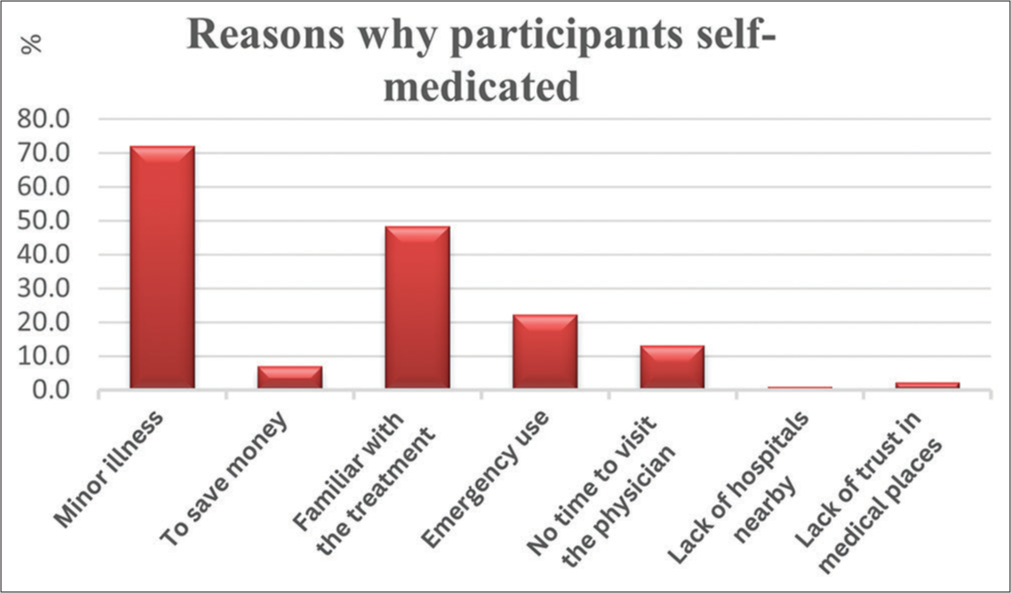
- Observed responses of participants.
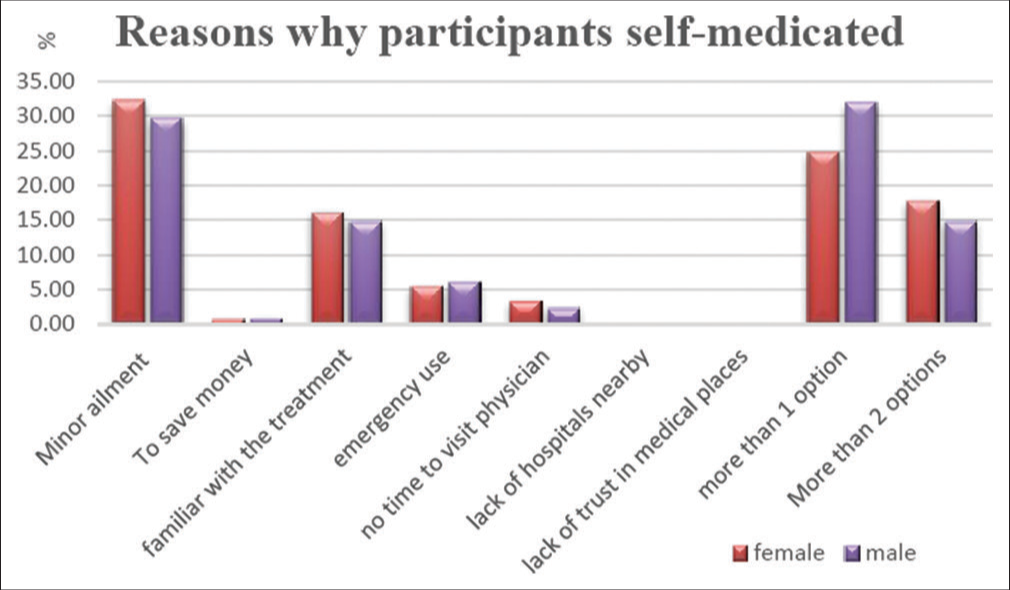
- Observed responses of participants based on gender.
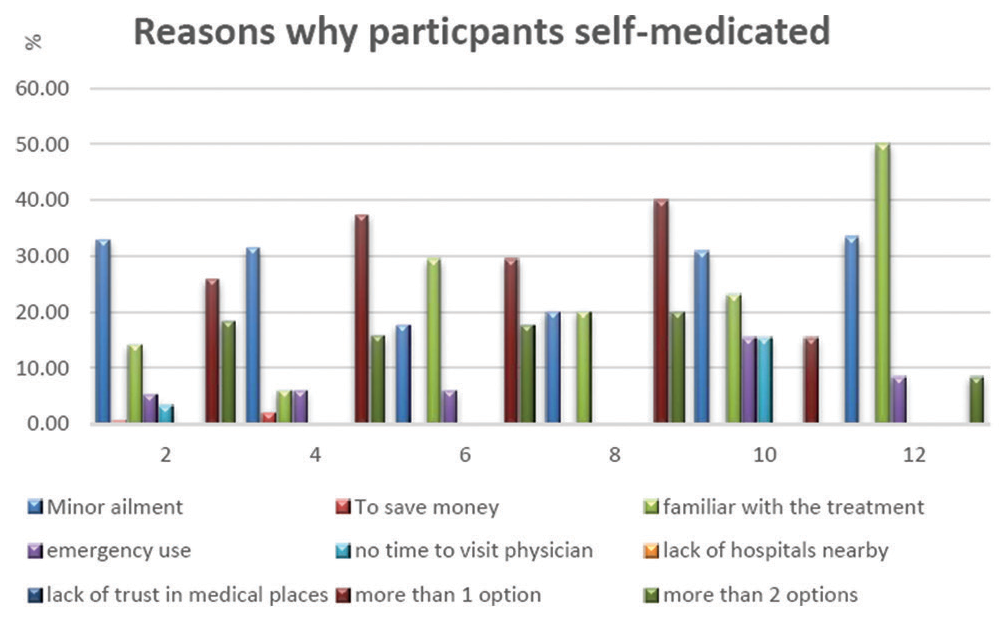
- Observed responses of participants based on age where 2: >20 years, 4: 21-30 years, 6: 31-40 years 8: 41-50 years,10: 51-60 years and 12: 60+years.
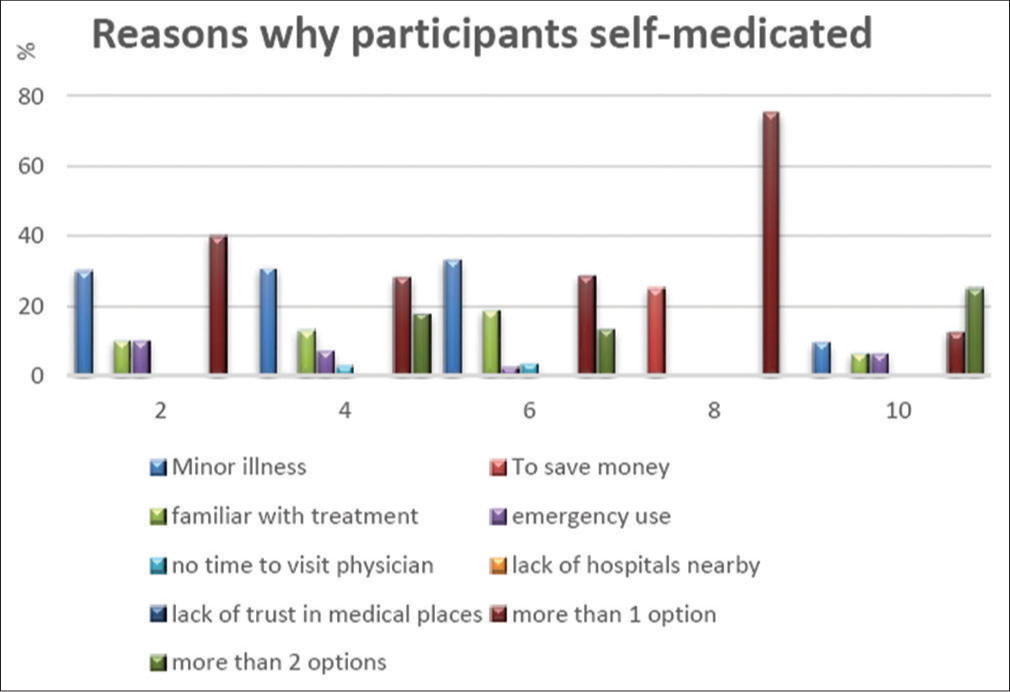
- Observed responses of participants based on literacy where 2: 10th pass, 4: 12th pass, 6: Graduate 8: Illiterate and 10: Postgraduate.
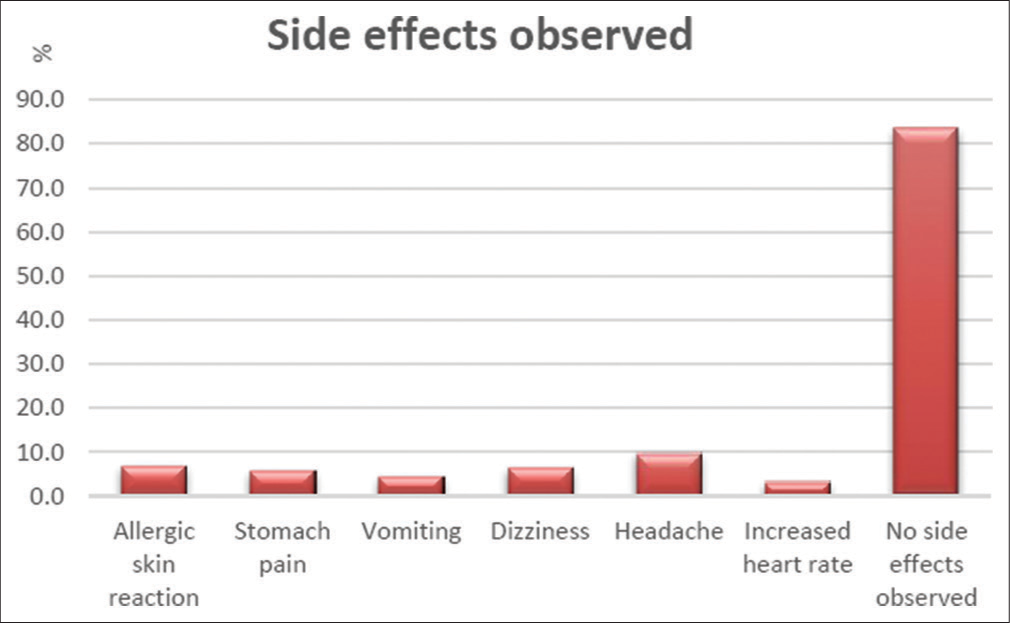
- Observed responses of participants regarding side effects.
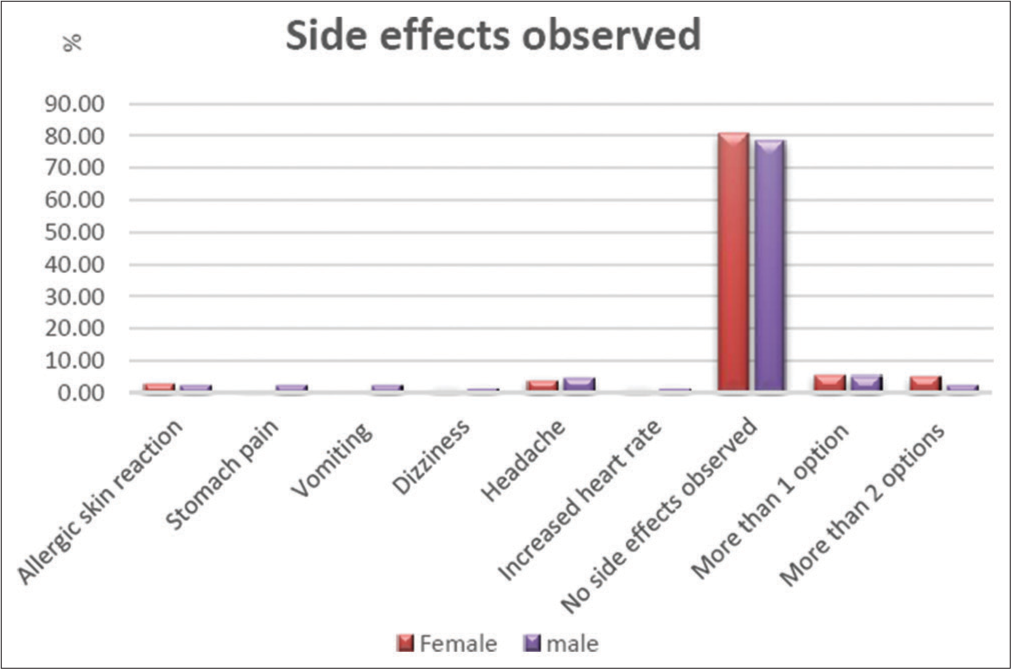
- Observed responses of participants based on gender.
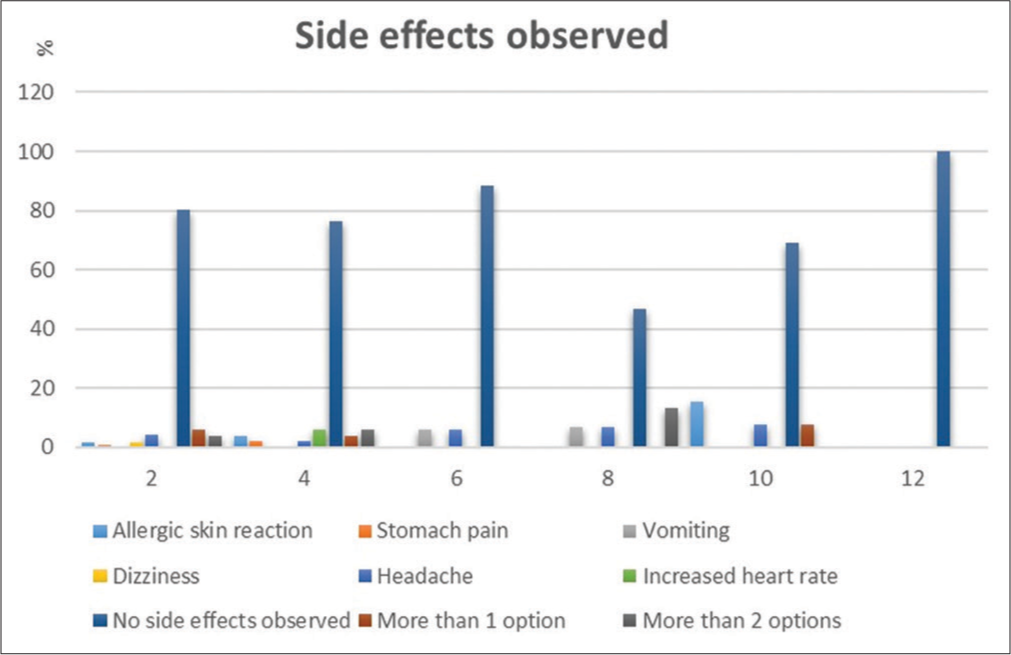
- Observed responses of participants based on age where 2: >20 years, 4: 21-30 years, 6: 31-40 years 8: 41-50 years,10: 51-60 years and 12: 60+years.
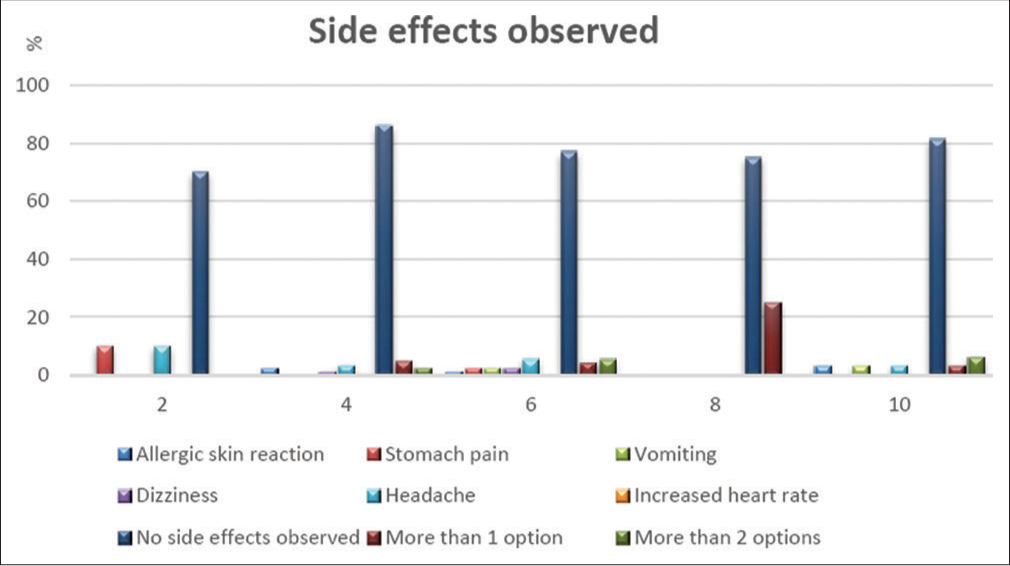
- Observed responses of participants based on literacy where 2: 10th pass, 4: 12th pass, 6: Graduate 8: Illiterate and 10: Postgraduate.
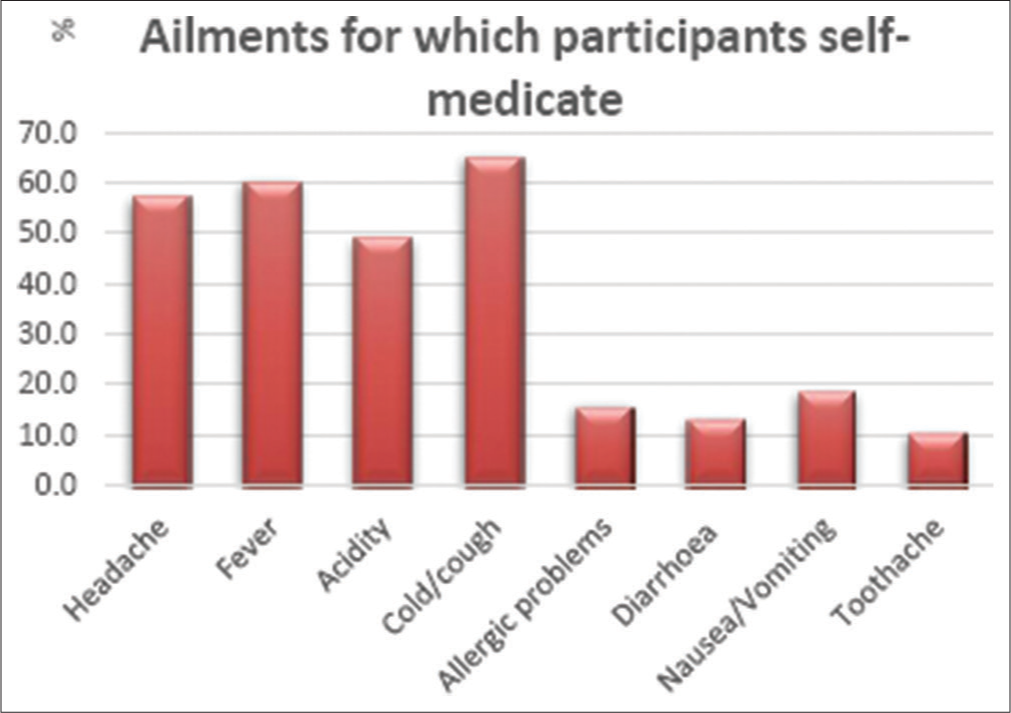
- Observed responses of participants.
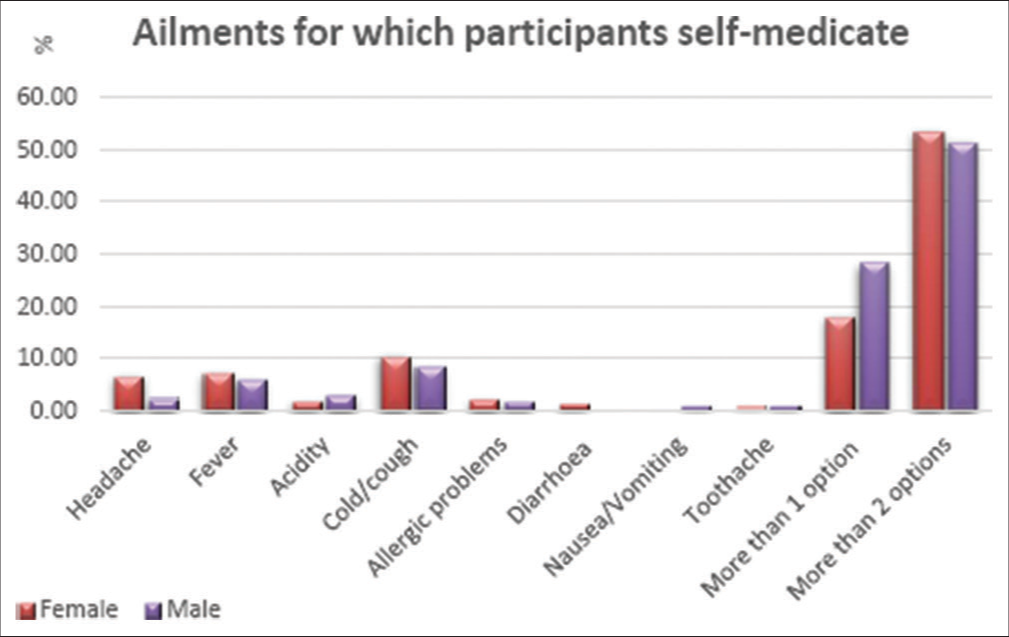
- Observed responses of participants based on gender.
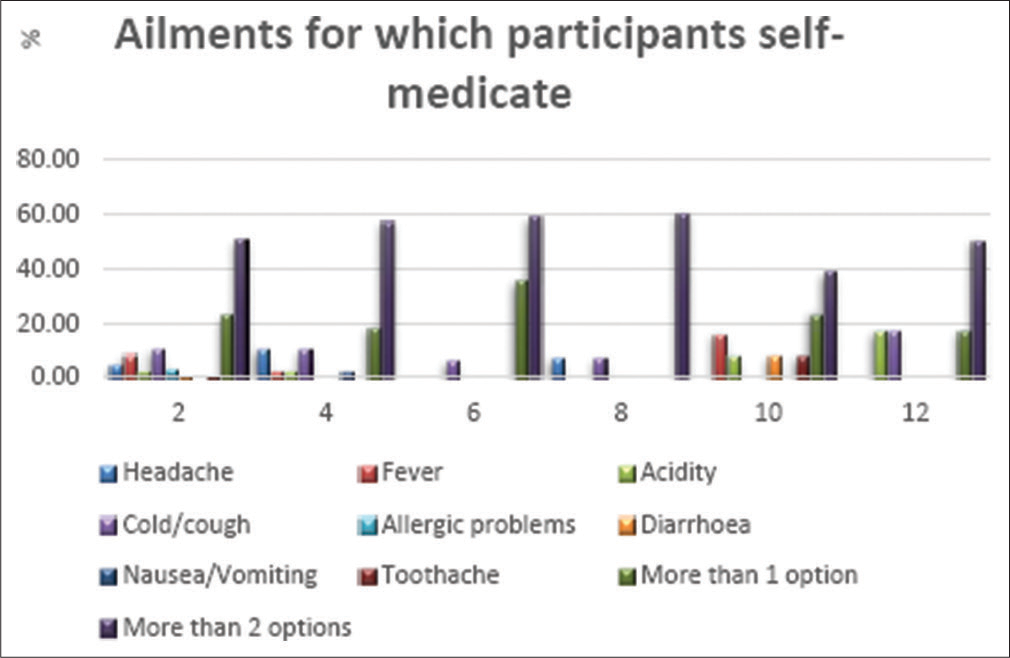
- Observed responses of participants based on age where 2: >20 years, 4: 21-30 years, 6: 31-40 years 8: 41-50 years,10: 51-60 years and 12: 60+years.
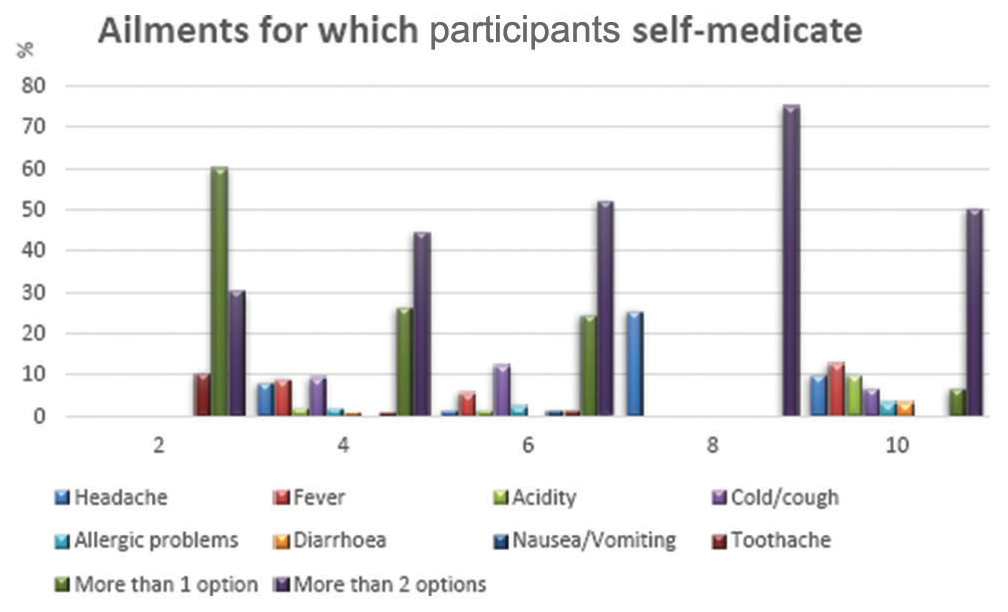
- Observed responses of participants based on literacy where 2: 10th pass, 4: 12th pass, 6: Graduate 8: Illiterate and 10: Postgraduate.
DISCUSSION
The rationale for self-medication has not changed over the past three decades. As is the case in our present study, family members or friends or a prior prescription were the primary sources of self-medication. This raises the possibility of consuming antibiotics from an unreliable source for conditions that are not always the same, as well as the possibility of using the wrong regimen and failing to take into account any concurrent use of medication by the patient.
Our survey revealed that 95.3% of the respondents self-medicated, with responses ranging from rarely to weekly. The primary reasons were minor illnesses and familiarity with the illness. Studies carried out across India revealed that 72% of people in Uttar Pradesh self-medicated although it was for dental issues, specifically.[19] Delhi showed a prevalence of 92.8%, primarily for common cold and fever.[20] In Chennai, 51.7% of people self-medicate, with the common cold being the most frequent reason.[21] Similar studies done in places outside of India showed the prevalence of self-medication to be 45.4% in Wuhan, where individuals self-medicated because they believed their sickness to be mild and that visiting a doctor would be “inconvenient,”[22] 12.8–77.1% in Ethiopia where many chose to self-medicate rather than pay a doctor’s fees for a common illness or minor ailment,[23] 35% in Brazil,[24] and 84.8% in Karachi with the most common reason being a previous experience with the same symptoms.[25]
Despite the high literacy rate within the sample population, only 17.5% of respondents believe self-medication to be unsafe and a vast number of them depended on a previous prescription or the pharmacist as their source. About 23.7% of respondents said that they got their medications from friends or family, while a larger percentage of participants said that they had suggested drugs to friends and family.
This survey included gender as a criterion due to the important role that gender plays in self-medication practices, but our research could not find any correlation between the amount of self-medication used by men and women.
However, a study among medical students in coastal South India found that women self-medicate more often than men,[10] while a different study conducted in Nepal’s Pokhara Valley revealed that men self-medicate more frequently than women.[26]
In the present study, the respondents were medicated mainly for cold/cough (64.8%) and fever (59.8%). A study done on the self-medication pattern in Haryana found that analgesics/antipyretics were increasingly popular choices to treat non-severe respiratory disorders (cold/cough).[27] According to a study done among medical students in North India, the most common causes of self-medication were headaches and the common cold.[28] Wuhan inhabitants reportedly self-medicated for gastrointestinal disorders, and cardiovascular conditions, including colds and coughs.[22]
Studies have shown that the use of antimicrobials to self-treat diseases is not uncommon, as antibiotics are the highest drug consumption category after analgesics/antipyretics and anti-inflammatory drugs.[29,30] However, there can be lethal consequences of abusing drugs, especially antimicrobials as antimicrobial resistance is a huge threat with situations such as multi-drug resistant tuberculosis or extreme drug-resistant tuberculosis in developing countries such as India and China.[31] In addition, there is a chance of hypersensitivity reactions, as demonstrated by a study on cutaneous adverse drug reactions, where using antibiotics and anti-inflammatory medicines resulted in skin disorders ranging from minor to life-threatening.[32] Headaches (9.7%) and allergic skin reactions (6.9%) were the most frequently reported adverse effects in our study. A separate study carried out in Ajman, United Arab Emirates, revealed that the most prevalent side effects were vomiting, nausea, and diarrhea. The results indicate that there is a chance that side effects could outweigh the intended therapeutic benefits when medical professionals are not consulted.
A higher prevalence of self-medication has been reported in adolescents[14] which is pertinent to our study as 66% of respondents of our survey were under the age of 20. On the contrary, a study conducted in a rural area of Northern India found that people between the ages of 36 and 60 were more likely to self-medicate than younger people.[17]
In light of contemporary concerns such as air pollution, climate change, antibiotic resistance, and concerted efforts by the government of India to eradicate chronic infectious diseases such as tuberculosis, this survey focuses on the harmful consequences of inappropriate self-medication.
The relevant authorities need to use multiple strategies for:
A greater widespread public awareness
Implementing strict guidelines for the distribution of pharmaceuticals through pharmacies
Strengthened oversight of the sale of pharmaceuticals to ensure that self-medication is viewed as a health risk that obstructs the achievement of several SDG and our attempts to end infectious diseases in developing nations.
Limitations
There is not a clear drug category that has been used for self-medication, but because it risks the possibility of increasing antimicrobial resistance; further study can be envisaged to know about the number of prescriptions generated for antimicrobials and the corresponding demand for antimicrobials without prescription.
CONCLUSION
Since ancient times, people have employed drugs in one way or another to treat ailments. The usage of medications has extended and become safer as a result of advances in the pharmaceutical industry. A lot of research and surveys must be conducted to learn more about the causes and effects of self-medication. Whether for lack of time or money, it makes little sense for people to visit a doctor for every minor ailment that they face; nonetheless, in order to live a sustainable life, the general public needs to actively participate. Regular health examinations, high-quality education, and living a fit and a healthy lifestyle can all help achieve this.
Acknowledgment
The authors acknowledge the participants of this study for active participation in the survey.
Ethical approval
The research/study approved by the Institutional Review Board at Ranjeet Deshmukh Dental College and Research Centre, Nagpur (formerly known as VSPM Dental College and Research Centre), number IEC/VSPMDCRC/03/2022, dated September 22, 2022.
Declaration of patient consent
Patient’s consent not required as there are no patients in this study.
Conflicts of interest
There are no conflicts of interest.
Use of artificial intelligence (AI)-assisted technology for manuscript preparation
The authors confirm that there was no use of artificial intelligence (AI)-assisted technology for assisting in the writing or editing of the manuscript and no images were manipulated using AI.
Financial support and sponsorship
Nil.
References
- Introduction: The nature of drugs and drug development and regulation In: Katzung BG, Vanderah TW, eds. Basic clinical pharmacology (15th ed). New York: McGraw Hill; 2021.
- [Google Scholar]
- What is there that is not poison? A study of the third Defense by Paracelsus. Arch Toxicol. 1986;58:207-13.
- [CrossRef] [PubMed] [Google Scholar]
- Evaluation of the perception, attitude and practice of self-medication among business students in 3 select Cities, South India. Int J Enterprise Innov Manag Stud. 2010;1:40-4.
- [Google Scholar]
- How and why are non-prescription analgesics used in Scotland? Fam Pract. 2005;22:78-85.
- [CrossRef] [PubMed] [Google Scholar]
- The value of self-medication: Summary of existing evidence. J Med Econ. 2018;21:201-11.
- [CrossRef] [PubMed] [Google Scholar]
- A qualitative study about self-medication in the community among market vendors in Fuzhou, China. Health Soc Care Community. 2011;19:504-13.
- [CrossRef] [PubMed] [Google Scholar]
- Antibiotic resistance associated with air quality and transferred by airborne particulate matter. Research Square [Preprint] 2020
- [CrossRef] [Google Scholar]
- Perceptions and practices of self-medication among medical students in coastal south India. PLoS One. 2013;8:e72247.
- [CrossRef] [PubMed] [Google Scholar]
- Inappropriate self-medication among adolescents and its association with lower medication literacy and substance use. PLoS One. 2017;12:e0189199.
- [CrossRef] [PubMed] [Google Scholar]
- Benefits and risks of self medication. Drug Saf. 2001;24:1027-37.
- [CrossRef] [PubMed] [Google Scholar]
- Extent and correlates of self-medication practice among community-dwelling adults in Eastern Ethiopia. Biomed Res Int. 2023;2023:4726010.
- [CrossRef] [PubMed] [Google Scholar]
- Self-medication practices in Mekelle, Ethiopia. PLoS One. 2014;9:e97464.
- [CrossRef] [PubMed] [Google Scholar]
- Use of self-medication among adolescents: A systematic review and meta-analysis. Eur J Public Health. 2014;25:444-50.
- [CrossRef] [PubMed] [Google Scholar]
- Self-medication: A current challenge. J Basic Clin Pharm. 2013;5:19-23.
- [CrossRef] [PubMed] [Google Scholar]
- Sustainable development goals (SDGs), and their implementation: A national global framework for health, development and equity needs a systems approach at every level. Br Med Bull. 2017;124:81-90.
- [CrossRef] [PubMed] [Google Scholar]
- Evaluation of self medication practices in rural area of town Sahaswan at Northern India. Ann Med Health Sci Res. 2014;4:S73-8.
- [CrossRef] [PubMed] [Google Scholar]
- Assessment of nature, reasons, and consequences of self-medication practice among general population of Ras Al-Khaimah, UAE. Int J Appl Basic Med Res. 2018;8:3-8.
- [CrossRef] [PubMed] [Google Scholar]
- Practice of self-medication for dental problems in Uttar Pradesh, India. Oral Health Prev Dent. 2016;14:5-11.
- [Google Scholar]
- Prevalence and pattern of self-medication practices in an urban area of Delhi, India. Med J Dr. D.Y. Patil Univ. 2015;8:16.
- [CrossRef] [Google Scholar]
- A cross sectional study on the prevalence of self-medication in a Chennai based population, Tamil Nadu, India. Int J Community Med Public Health. 2017;4:418-23.
- [CrossRef] [Google Scholar]
- Self-medication practice and associated factors among residents in Wuhan, China. Int J Environ Res Public Health. 2018;15:68.
- [CrossRef] [PubMed] [Google Scholar]
- Self-medication practice in Ethiopia: A systematic review. Patient Prefer Adherence. 2017;11:401-13.
- [CrossRef] [PubMed] [Google Scholar]
- Prevalence of self-medication in the adult population of Brazil: A systematic review. Rev Saúde Pública. 2015;49:36.
- [CrossRef] [PubMed] [Google Scholar]
- Prevalence and pattern of self-medication in Karachi: A community survey. Pak J Med Sci. 2015;31:1241-5.
- [CrossRef] [PubMed] [Google Scholar]
- Self-medication and non-doctor prescription practices in Pokhara valley, Western Nepal: A questionnaire-based study. BMC Family Pract. 2002;3:17.
- [CrossRef] [PubMed] [Google Scholar]
- Statistical study on self medication pattern in Haryana, India. Indo Global J Pharm Sci. 2012;2:21-35.
- [CrossRef] [Google Scholar]
- Self-medication patterns among medical students in North India. Curr Trends Biomed Eng Biosci. 2018;8:18.
- [Google Scholar]
- Self-medication among children and adolescents. Curr Drug Saf. 2010;5:324-8.
- [CrossRef] [PubMed] [Google Scholar]
- Self-medication with antibiotics in the ambulatory care setting within the Euro-Mediterranean region; results from the ARMed project. J Infect Public Health. 2009;2:189-97.
- [CrossRef] [PubMed] [Google Scholar]
- High levels of multidrug resistant tuberculosis in new and treatment-failure patients from the Revised National Tuberculosis Control Programme in an urban metropolis (Mumbai) in Western India. BMC Public Health. 2009;9:211.
- [CrossRef] [PubMed] [Google Scholar]
- Drugs and the skin: A concise review of cutaneous adverse drug reactions. Br J Clin Pharmacol 2022
- [CrossRef] [PubMed] [Google Scholar]






